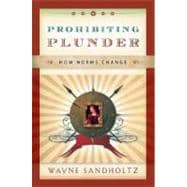
Note: Supplemental materials are not guaranteed with Rental or Used book purchases.
Purchase Benefits
Looking to rent a book? Rent Prohibiting Plunder How Norms Change [ISBN: 9780195337235] for the semester, quarter, and short term or search our site for other textbooks by Sandholtz, Wayne. Renting a textbook can save you up to 90% from the cost of buying.
| Acknowledgments | p. VII |
| List of Figures | p. XI |
| International Norm Change | p. 1 |
| Plunder and the Spoils of Victory | p. 31 |
| Napoleonic Plunder and the Emergence of Norms | p. 47 |
| The International Law Activists: Elaborating Norms in the Nineteenth Century | p. 71 |
| The Great War and the Protection of Art | p. 101 |
| Nazi Plunder: Strengthening the Rules | p. 127 |
| Codifying Norms: Nuremberg and the Hague | p. 167 |
| War in the 1990s: Crimes against Cultural Heritage | p. 191 |
| Repercussions of Nazi Plunder: Internalizing International Norms | p. 211 |
| Baghdad and Beyond | p. 241 |
| Dynamics of International Norm Change | p. 261 |
| References | p. 273 |
| Index | p. 327 |
| Table of Contents provided by Ingram. All Rights Reserved. |
The New copy of this book will include any supplemental materials advertised. Please check the title of the book to determine if it should include any access cards, study guides, lab manuals, CDs, etc.
The Used, Rental and eBook copies of this book are not guaranteed to include any supplemental materials. Typically, only the book itself is included. This is true even if the title states it includes any access cards, study guides, lab manuals, CDs, etc.